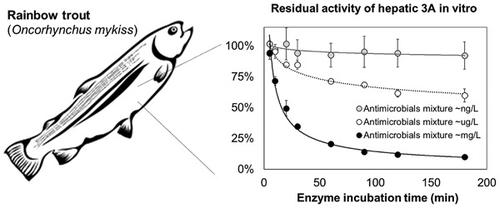当前位置:
X-MOL 学术
›
Environ. Toxicol. Chem.
›
论文详情
Our official English website, www.x-mol.net, welcomes your
feedback! (Note: you will need to create a separate account there.)
Cytochrome P450 Inhibition by Antimicrobials and Their Mixtures in Rainbow Trout Liver Microsomes In Vitro
Environmental Toxicology and Chemistry ( IF 3.6 ) Pub Date : 2021-07-13 , DOI: 10.1002/etc.5160 Tea L M Pihlaja 1 , Sanna M Niemissalo 1 , Tiina M Sikanen 1
Environmental Toxicology and Chemistry ( IF 3.6 ) Pub Date : 2021-07-13 , DOI: 10.1002/etc.5160 Tea L M Pihlaja 1 , Sanna M Niemissalo 1 , Tiina M Sikanen 1
Affiliation

|
Antimicrobials are ubiquitous in the environment and can bioaccumulate in fish. In the present study, we determined the half-maximal inhibitory concentrations (IC50) of 7 environmentally abundant antimicrobials (ciprofloxacin, clarithromycin, clotrimazole, erythromycin, ketoconazole, miconazole, and sulfamethoxazole) on the cytochrome P450 (CYP) system in rainbow trout (Oncorhynchus mykiss) liver microsomes, using 7-ethoxyresorufin O-deethylation (EROD, CYP1A) and 7-benzyloxy-4-trifluoromethylcoumarin O-debenzylation (BFCOD, CYP3A) as model reactions. Apart from ciprofloxacin and sulfamethoxazole, all antimicrobials inhibited either EROD or BFCOD activities or both at concentrations <500 µM. Erythromycin was the only selective and time-dependent inhibitor of BFCOD. Compared with environmental concentrations, the IC50s of individual compounds were generally high (greater than milligrams per liter); but as mixtures, the antimicrobials resulted in strong, indicatively synergistic inhibitions of both EROD and BFCOD at submicromolar (~micrograms per liter) mixture concentrations. The cumulative inhibition of the BFCOD activity was detectable even at picomolar (~nanograms per liter) mixture concentrations and potentiated over time, likely because of the strong inhibition of CYP3A by ketoconazole (IC50 = 1.7 ± 0.3 µM) and clotrimazole (IC50 = 1.2 ± 0.2 µM). The results suggest that if taken up by fish, the mixtures of these antimicrobials may result in broad CYP inactivation and increase the bioaccumulation risk of any other xenobiotic normally cleared by the hepatic CYPs even at biologically relevant concentrations. Environ Toxicol Chem 2022;41:663–676. © 2021 The Authors. Environmental Toxicology and Chemistry published by Wiley Periodicals LLC on behalf of SETAC.
中文翻译:

抗微生物剂及其混合物在体外抑制虹鳟肝微粒体中的细胞色素 P450
抗菌剂在环境中无处不在,并且可以在鱼类中进行生物累积。在本研究中,我们确定了 7 种环境丰富的抗菌剂(环丙沙星、克拉霉素、克霉唑、红霉素、酮康唑、咪康唑和磺胺甲恶唑)对虹鳟鱼(Oncorhynchus )细胞色素 P450 (CYP) 系统的半数最大抑制浓度 (IC50)我的吻) 肝微粒体,使用 7-ethoxyresorufin O-deethylation (EROD, CYP1A) 和 7-benzyloxy-4-trifluoromethylcoumarin O-debenzylation (BFCOD, CYP3A) 作为模型反应。除环丙沙星和磺胺甲恶唑外,所有抗菌剂在浓度 <500 µM 时均抑制 EROD 或 BFCOD 活性或两者均抑制。红霉素是唯一的选择性和时间依赖性 BFCOD 抑制剂。与环境浓度相比,个别化合物的IC50普遍较高(大于毫克/升);但作为混合物,抗微生物剂在亚微摩尔(~微克每升)混合物浓度下对 EROD 和 BFCOD 产生强烈的、指示性的协同抑制。即使在皮摩尔(约每升纳克)混合物浓度下也可检测到 BFCOD 活性的累积抑制,并且随着时间的推移而增强,可能是因为酮康唑 (IC50 = 1.7 ± 0.3 µM) 和克霉唑 (IC50 = 1.2 ± 0.2 µM) 强烈抑制 CYP3A。结果表明,如果被鱼吸收,这些抗菌剂的混合物可能会导致广泛的 CYP 失活,并增加任何其他通常被肝脏 CYP 清除的外源物质的生物蓄积风险,即使在生物学相关浓度下也是如此。环境毒物化学2022;41:663–676。© 2021 作者。Wiley Periodicals LLC 代表 SETAC 出版的Environmental Toxicology and Chemistry 。
更新日期:2021-07-13
中文翻译:

抗微生物剂及其混合物在体外抑制虹鳟肝微粒体中的细胞色素 P450
抗菌剂在环境中无处不在,并且可以在鱼类中进行生物累积。在本研究中,我们确定了 7 种环境丰富的抗菌剂(环丙沙星、克拉霉素、克霉唑、红霉素、酮康唑、咪康唑和磺胺甲恶唑)对虹鳟鱼(Oncorhynchus )细胞色素 P450 (CYP) 系统的半数最大抑制浓度 (IC50)我的吻) 肝微粒体,使用 7-ethoxyresorufin O-deethylation (EROD, CYP1A) 和 7-benzyloxy-4-trifluoromethylcoumarin O-debenzylation (BFCOD, CYP3A) 作为模型反应。除环丙沙星和磺胺甲恶唑外,所有抗菌剂在浓度 <500 µM 时均抑制 EROD 或 BFCOD 活性或两者均抑制。红霉素是唯一的选择性和时间依赖性 BFCOD 抑制剂。与环境浓度相比,个别化合物的IC50普遍较高(大于毫克/升);但作为混合物,抗微生物剂在亚微摩尔(~微克每升)混合物浓度下对 EROD 和 BFCOD 产生强烈的、指示性的协同抑制。即使在皮摩尔(约每升纳克)混合物浓度下也可检测到 BFCOD 活性的累积抑制,并且随着时间的推移而增强,可能是因为酮康唑 (IC50 = 1.7 ± 0.3 µM) 和克霉唑 (IC50 = 1.2 ± 0.2 µM) 强烈抑制 CYP3A。结果表明,如果被鱼吸收,这些抗菌剂的混合物可能会导致广泛的 CYP 失活,并增加任何其他通常被肝脏 CYP 清除的外源物质的生物蓄积风险,即使在生物学相关浓度下也是如此。环境毒物化学2022;41:663–676。© 2021 作者。Wiley Periodicals LLC 代表 SETAC 出版的Environmental Toxicology and Chemistry 。











































 京公网安备 11010802027423号
京公网安备 11010802027423号